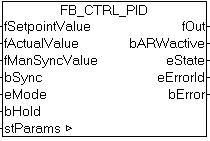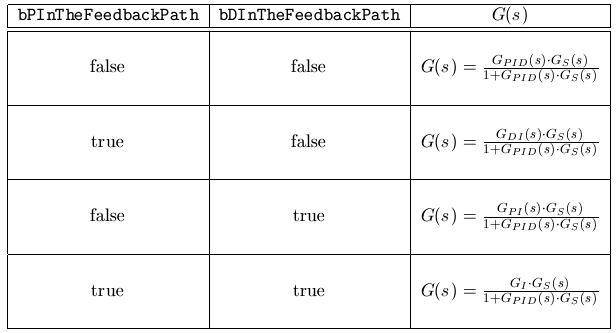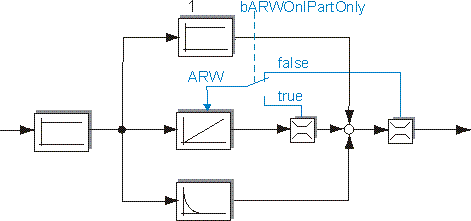FB_CTRL_PID

The function block provides a PID transfer element in the functional diagram.
Transfer function:
The following transfer function can be declared for this block, if the boolean inputs bPInTheFeedbackPath and bDInTheFeedbackPath are set to FALSE, otherwise this transfer function only describes a part of the blocks behaviour:
Functional diagram:

The standard functional diagram of a PID controller in additive form has been expanded by the two active boolean inputs bPInTheFeedbackPath and bDInTheFeedbackPath (which act as "switches"), so that a modified functional diagram can be activated.
Control background: due to the differential component of the control algorithm, large control values are generated at setpoint step-changes, which cause a strain on the control elements and may cause the control system to oscillate. A control algorithm with a differential component that is only applied to the controlled variable ( bDInTheFeedbackPath := TRUE ) can avoid this problem.
The bPInTheFeedbackPath and bDInTheFeedbackPath inputs permit the closed control loop to implement the following transfer functions:

with:

! The default setting for the two inputs bPInTheFeedbackPath and bDInTheFeedbackPath is FALSE. The PID controller then acts as a standard PID controller in additive form.

Step response:

ARW:

VAR_INPUT
VAR_INPUT
fSetpointValue : FLOAT;
fActualValue : FLOAT;
fManSyncValue : FLOAT;
bSync : BOOL;
eMode : E_CTRL_MODE;
bHold : BOOL;
END_VAR
fSetpointValue : Set value of the controlled variable.
fActualValue : Actual value of the controlled variable.
fManSyncValue : Input, to whose value it is possible to set the internal state of the PID element.
bSync : A rising edge at this input sets the PID element to the value fManSyncValue.
eMode : Input that specifies the block's operating mode.
bHold : A TRUE at this input will hold the internal state (and therefore also the output) constant at its current value, independently of the system deviation.
VAR_OUTPUT
VAR_OUTPUT
fOut : FLOAT;
bARWactive : BOOL;
eState : E_CTRL_STATE;
eErrorId : E_CTRL_ERRORCODES;
bError : BOOL;
END_VAR
fOut : Output of the PID element.
bARWactive : A TRUE at this output indicates that the PID element is being restricted.
eState : State of the function block.
eErrorId : Supplies the error number when the bError output is set.
bError : Becomes TRUE, as soon as an error occurs.
VAR_IN_OUT
VAR_IN_OUT
stParams : ST_CTRL_PID_PARAMS;
END_VAR
stParams : Parameter structure of the PID element. This consists of the following elements:
TYPE
ST_CTRL_PID_PARAMS :
STRUCT
tCtrlCycleTime : TIME := T#0ms; (* controller
cycle time [TIME] *)
tTaskCycleTime : TIME := T#0ms; (* task cycle
time [TIME] *)
fKp : FLOAT := 0; (* proportional
gain *)
tTn : TIME := T#0ms; (* Tn *)
tTv : TIME := T#0ms; (* Tv *)
tTd : TIME := T#0ms; (* Td *)
fOutMaxLimit : FLOAT := 1E38; (* maximum
output limit *)
fOutMinLimit : FLOAT := -1E38; (* minimum
output limit *)
bPInTheFeedbackPath : BOOL;
bDInTheFeedbackPath : BOOL;
bARWOnIPartOnly : BOOL;
END_STRUCT
END_TYPE
tCtrlCycleTime : Cycle time with which the control loop is processed. This must be greater than or equal to the TaskCycleTime. The function block uses this input value to calculate internally whether the state and the output values have to be updated in the current cycle.
tTaskCycleTime: Cycle time with which the function block is called. If the function block is called in every cycle this corresponds to the task cycle time of the calling task.
fKp : Controller amplification / controller coefficient
tTn : Integral action time. The I-component is deactivated if this is parameterized as T#0s.
tTv : Derivative action time. The D-component is deactivated if this is parameterized as T#0s.
tTd : Damping time
fOutMaxLimit : Upper limit at which integration is halted and to which the output is limited (ARW measure). Reaching this limit is indicated by a TRUE at the bARWActive output.
fOutMinLimit : Lower limit at which integration is halted and to which the output is limited (ARW measure). Reaching this limit is indicated by a TRUE at the bARWActive output.
bPInTheFeedbackPath : Input value of the internal P element can be selected with this input (see functional diagram). Default setting: FALSE
bDInTheFeedbackPath : Input value of the internal D element can be selected with this input (see functional diagram). Default setting: FALSE
bARWOnIPartOnly: If this parameter is FALSE (the default setting), the integration of the I-component is halted if the complete controller output reaches the upper or lower limit. If it is TRUE, the integration is halted if the I-component (the output of the integrator) reaches some limit. (Cf. functional diagram)